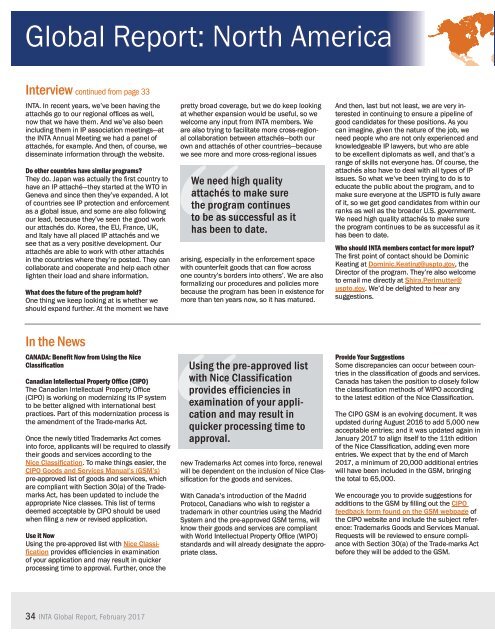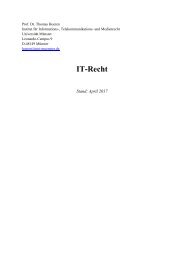GlobalReport
QqMg309yB9H
QqMg309yB9H
You also want an ePaper? Increase the reach of your titles
YUMPU automatically turns print PDFs into web optimized ePapers that Google loves.
Global Report: North America<br />
Interview continued from page 33<br />
INTA. In recent years, we’ve been having the<br />
attachés go to our regional offices as well,<br />
now that we have them. And we’ve also been<br />
including them in IP association meetings—at<br />
the INTA Annual Meeting we had a panel of<br />
attachés, for example. And then, of course, we<br />
disseminate information through the website.<br />
Do other countries have similar programs?<br />
They do. Japan was actually the first country to<br />
have an IP attaché—they started at the WTO in<br />
Geneva and since then they’ve expanded. A lot<br />
of countries see IP protection and enforcement<br />
as a global issue, and some are also following<br />
our lead, because they’ve seen the good work<br />
our attachés do. Korea, the EU, France, UK,<br />
and Italy have all placed IP attachés and we<br />
see that as a very positive development. Our<br />
attachés are able to work with other attachés<br />
in the countries where they’re posted. They can<br />
collaborate and cooperate and help each other<br />
lighten their load and share information.<br />
What does the future of the program hold?<br />
One thing we keep looking at is whether we<br />
should expand further. At the moment we have<br />
pretty broad coverage, but we do keep looking<br />
at whether expansion would be useful, so we<br />
welcome any input from INTA members. We<br />
are also trying to facilitate more cross-regional<br />
collaboration between attachés—both our<br />
own and attachés of other countries—because<br />
we see more and more cross-regional issues<br />
We need high quality<br />
attachés to make sure<br />
the program continues<br />
to be as successful as it<br />
has been to date.<br />
arising, especially in the enforcement space<br />
with counterfeit goods that can flow across<br />
one country’s borders into others’. We are also<br />
formalizing our procedures and policies more<br />
because the program has been in existence for<br />
more than ten years now, so it has matured.<br />
And then, last but not least, we are very interested<br />
in continuing to ensure a pipeline of<br />
good candidates for these positions. As you<br />
can imagine, given the nature of the job, we<br />
need people who are not only experienced and<br />
knowledgeable IP lawyers, but who are able<br />
to be excellent diplomats as well, and that’s a<br />
range of skills not everyone has. Of course, the<br />
attachés also have to deal with all types of IP<br />
issues. So what we’ve been trying to do is to<br />
educate the public about the program, and to<br />
make sure everyone at the USPTO is fully aware<br />
of it, so we get good candidates from within our<br />
ranks as well as the broader U.S. government.<br />
We need high quality attachés to make sure<br />
the program continues to be as successful as it<br />
has been to date.<br />
Who should INTA members contact for more input?<br />
The first point of contact should be Dominic<br />
Keating at Dominic.Keating@uspto.gov, the<br />
Director of the program. They’re also welcome<br />
to email me directly at Shira.Perlmutter@<br />
uspto.gov. We’d be delighted to hear any<br />
suggestions.<br />
In the News<br />
CANADA: Benefit Now from Using the Nice<br />
Classification<br />
Canadian Intellectual Property Office (CIPO)<br />
The Canadian Intellectual Property Office<br />
(CIPO) is working on modernizing its IP system<br />
to be better aligned with international best<br />
practices. Part of this modernization process is<br />
the amendment of the Trade-marks Act.<br />
Once the newly titled Trademarks Act comes<br />
into force, applicants will be required to classify<br />
their goods and services according to the<br />
Nice Classification. To make things easier, the<br />
CIPO Goods and Services Manual’s (GSM’s)<br />
pre-approved list of goods and services, which<br />
are compliant with Section 30(a) of the Trademarks<br />
Act, has been updated to include the<br />
appropriate Nice classes. This list of terms<br />
deemed acceptable by CIPO should be used<br />
when filing a new or revised application.<br />
Use it Now<br />
Using the pre-approved list with Nice Classification<br />
provides efficiencies in examination<br />
of your application and may result in quicker<br />
processing time to approval. Further, once the<br />
Using the pre-approved list<br />
with Nice Classification<br />
provides efficiencies in<br />
examination of your application<br />
and may result in<br />
quicker processing time to<br />
approval.<br />
new Trademarks Act comes into force, renewal<br />
will be dependent on the inclusion of Nice Classification<br />
for the goods and services.<br />
With Canada’s introduction of the Madrid<br />
Protocol, Canadians who wish to register a<br />
trademark in other countries using the Madrid<br />
System and the pre-approved GSM terms, will<br />
know their goods and services are compliant<br />
with World Intellectual Property Office (WIPO)<br />
standards and will already designate the appropriate<br />
class.<br />
Provide Your Suggestions<br />
Some discrepancies can occur between countries<br />
in the classification of goods and services.<br />
Canada has taken the position to closely follow<br />
the classification methods of WIPO according<br />
to the latest edition of the Nice Classification.<br />
The CIPO GSM is an evolving document. It was<br />
updated during August 2016 to add 5,000 new<br />
acceptable entries; and it was updated again in<br />
January 2017 to align itself to the 11th edition<br />
of the Nice Classification, adding even more<br />
entries. We expect that by the end of March<br />
2017, a minimum of 20,000 additional entries<br />
will have been included in the GSM, bringing<br />
the total to 65,000.<br />
We encourage you to provide suggestions for<br />
additions to the GSM by filling out the CIPO<br />
feedback form found on the GSM webpage of<br />
the CIPO website and include the subject reference:<br />
Trademarks Goods and Services Manual.<br />
Requests will be reviewed to ensure compliance<br />
with Section 30(a) of the Trade-marks Act<br />
before they will be added to the GSM.<br />
34 INTA Global Report, February 2017





